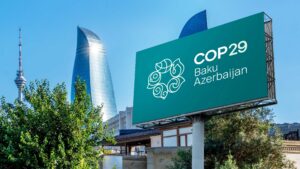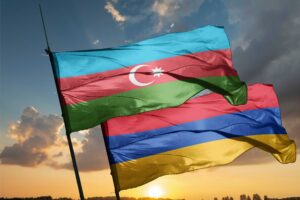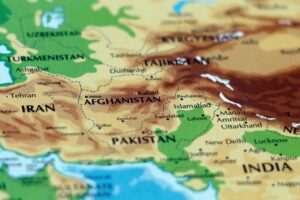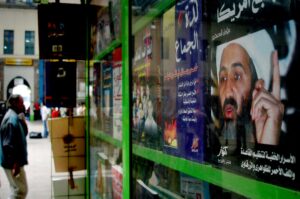The Russian invasion of Ukraine has unleashed a new dynamic between Washington and Moscow, and once again Iran finds itself at the center of a brewing geopolitical and economic rivalry between these two powers. It is often said that when there is an intense conflict of interest between Moscow and Washington, Tehran has the opportunity to exploit it by pursuing a balancing act. It is a theory that we have heard before, although views vary on its validity today. We can all agree that this theory has lost its traction among members of the current leadership in Iran. Two questions persist: (1) might the Ukraine crisis lead to an opening in US-Iranian relations? And (2) could Iran exploit this opportunity to gain access to the West’s energy markets? The brief answer to both questions are “maybe” in the short term but “no” in the long term, in part because US sanctions on Iran over the past four decades have slowly but systematically pushed the Islamic Republic into the arms of Russia and China.
Iranians now have the option to capitalize on new economic opportunities that are emerging from Russia’s international isolation.
Some observers have echoed a similar sentiment, pointing to the deeply-seated mistrust between Tehran and Washington. They argue that the Iranians now have the option to capitalize on new economic opportunities that are emerging from Russia’s international isolation. The conservative ruling class in Tehran appears to be driven more by its ideational priorities rather than rational, commercial interests. But the fact remains that it is not only Iran that is responsible for this situation. For decades, the United States and Europe have consistently cut off the country from all major energy trade and transit routes that linked the broader Middle East to European markets.[i] The Ukraine war could give the United States and Europe a reason to reassess Iran’s economic isolation. At the same time, however, Tehran would have to rethink its foreign policy priorities to have any chance to succeed.[ii]
Reactions to the Russian Invasion of Ukraine
The reaction of Iranian President Ebrahim Raisi to the invasion of Ukraine has been both calculated and cautious, avoiding criticism of Russia while also calling for a ceasefire and immediate negotiations for the political resolution of the crisis. Iranian Foreign Minister Hossein Amir-Abdollahian has also avoided condemning the invasion or even calling it an act of unprovoked aggression, while noting that “The Ukraine crisis is rooted in NATO provocations.”[iii]
Iran’s abstention during the UN General Assembly vote condemning Russia on 2 March 2022 illustrated Tehran’s reluctance to endorse Moscow’s violation of Ukraine’s territorial integrity. Iran also voted against the resolution of the UN General Assembly on calling for Russia to be suspended from the Human Rights Council.[iv] Explaining the decision, Majid Takht-Ravanchi, the Ambassador of Iran to the United Nations, said: “Iran considers this resolution to be politically motivated and believes that it undermines the neutrality of the United Nations.”[v]
Tehran refuses to openly support Russian military campaigns.
The reasons for Iran’s seemingly ultra-cautious response to the invasion of Ukraine can be traced back to Tehran’s relations with Moscow over the past few decades, especially in Tehran’s deteriorating relations with Washington under the Trump administration. Although Iran has refrained from denouncing the Russian invasion of Ukraine, it has never recognized the territories forcibly controlled by Moscow. Iran, for example, never recognized the annexation of Crimea to Russia carried out in 2014.[vi] Even today Tehran refuses to openly support Russian military campaigns for the fear that such an act may in the future be used against Iran itself in some of its border provinces where there are separatist sentiments, such as among some Azeris and Kurds.
The Link to the Nuclear Talks
Fears of oil supply disruptions could prompt further progress toward signing an additional nuclear accord with Iran.
This crisis, however, could strengthen Iran’s bargaining position in the ongoing nuclear talks (also known as the Joint Comprehensive Plan of Action, or JCPOA), as Washington and its Western allies might be looking for ways to facilitate Iranian exports of oil and gas to global markets in order to bolster global supply. Arguably, fears of oil supply disruptions could prompt further progress toward signing an additional nuclear accord with Iran. The overlapping interests of Iran and the United States appear much more viable than before.
To counter such a possibility, Sergey Lavrov, Foreign Minister of Russia, has tried to link the final approval of the revived Iran nuclear deal to lifting sanctions on his country’s economic cooperation with Iran.[vii] Following the West’s sanctions on Russia in response to the invasion of Ukraine, Moscow has tried to use Iran as an option to circumvent the sanctions—a move that could undermine Iran’s national interests after a possible revival of the JCPOA. It should be noted, however, that what has held up the nuclear talks is a sanction that the Trump administration placed in 2019 on a branch of the Iranian armed forces, known as the Islamic Revolutionary Guard Corps (IRGC), which has designated them as a foreign terrorist organization (FTO). Although largely symbolic, this designation has presented a political barrier to the successful continuation of the nuclear talks.
Russia and Iran have started cooperating to connect their interbank systems.
Meanwhile, Kazem Jalali, Iran’s ambassador to Russia, has announced that Russia and Iran have started cooperating to connect their interbank systems in order to bypass the SWIFT financial transaction network.[viii] It should be noted that Russia has its own payment mechanism called the Financial Transfer System (SPFS), which has a similar function to SWIFT and allows the transfer of messages in the form of SWIFT. This financial transaction network was created as a replacement for SWIFT and has been developed by the Bank of Russia since 2014.
It should be mentioned, however, that the SPFS system was working only for the countries that had friendly relations with Russia, namely those that belonged to the group of former Soviet Union republics—and were willing to do business with Moscow in ruble. Even those republics preferred using the SWIFT system, relying heavily on US dollars, the euro, and other major hard currencies prior to the Russian invasion of Ukraine. Very few countries, such as China and Cuba, agreed to do business with the SPFS system. Iran, however, could not use SPFS in large part owing to the fact that Iranian banks and Iran’s Central Bank were subject to US sanctions. The secondary sanctions were also effective, preventing Russian and Chinese banks, which had to comply with such sanctions, from doing any business with Iranian banks.[ix]
To seek an alternative to SPFS, Iran and Russia agreed to trade in ruble in another system called pool. According to this arrangement, whatever Iran was selling to Russia, the money was going into this pool and whatever Iran was buying from Russia could be deducted from this pool. Since the Russian business community preferred to receive hard currency for their sales to Iran, this system proved untenable over time. As a result, Iran’s agreement of bilateral trade (the so-called oil-for-goods deal) with Russia, which at one point was presumed to reach nearly $20 billion annually, fell by the wayside.[x] Reportedly, much of the trade between the two countries was managed by hard currency payments via UAE or Turkey.[xi]
Since the Russian invasion of Ukraine, the joint committee of trade between Russia and Iran has been trying to include Iran in their SPFS, yet Russian suppliers appear reluctant to accept ruble for sales to Iran. In fact, Russian suppliers, as well as other governmental entities, are asking for hard currencies for their exports. Similarly, for their part, Iranian exporters have shown little interest in doing business with Russia in rubles. Understandably, both sides continue to prefer to pay for charges/risks and receive hard currencies rather than deal in Ruble. For India, the currency in the pool was Rupee (INR), and the pool system was somehow working up until 2018 when India chose to buy zero oil and gas from Iran. Consequently, the pool became empty.
Insofar as bypassing global sanctions and financial barriers are concerned, Iran has in the past pursued similar routes.
In the case of Iran, while these systems are not new, many agreements remained on paper without actually becoming enforceable contracts. Insofar as bypassing global sanctions and financial barriers are concerned, Iran has in the past pursued similar routes. In one case, Iran was able to import drugs through the Swiss Independent Financial Channel (July 2020), following Trump’s withdrawal from the JCPOA. Although the channel was independent of the SWIFT mechanism, it was licensed by the US Treasury Department.[xii] In another case in March 2020, Iran managed to conduct non-dollar trade through the independent channel INSTEX.[xiii] In still another case, Iran supported the creation of an independent Iran-India financial channel. Ali Chegini, Iran’s ambassador to India, underlined the importance of such a channel, suggesting that if Iran and India could set up a rupee-rial trade mechanism, the volume of trade between the two countries would likely reach $30 billion.[xiv]
Moscow intends to exploit new trade arrangements with Iran as a back door to enable it to evade these sanctions.
With regard to Russia, Rouhollah Latifi, the spokesperson of the Islamic Republic of Iran Customs Administration (IRICA), has also stated that Iran can serve as a corridor to meet Russia’s needs in the face of Western sanctions against Moscow.[xv] To that end, the Russian Ambassador to Iran, Levan Dzhagaryan, has met with Iranian trade officials and discussed the expansion of trade relations with Iran.[xvi] Subsequently, a large Iran-Russia trade conference with representatives of more than 350 Iranian and Russian companies was held in Russia on April 7, 2022.[xvii] Ironically, when Iran was under sanctions, Russia even refused to give the S300 missile system to Iran for 10 years under the pretext of sanctions. Now that the U.S. and its European allies have imposed unprecedented sanctions on Russia, Moscow intends to exploit new trade arrangements with Iran as a back door to enable it to evade these sanctions.[xviii]
At the same time, Russia realizes that Washington now more than ever needs to revive the Iran nuclear talks as a way of finding an alternative to the disruption of Russian oil supplies on the world energy market. With growing sanctions on its oil industry, Moscow fears that Iran’s oil entry into global energy markets would offset the absence of its own oil exports. Although many Iranian diplomats have spoken in favor of de-linking these issues within the context of JCPOA negotiations, President Raisi has prioritized good relations with Russia over maintaining normal economic ties with the West. Russia’s delaying tactics in negotiations over the Iran nuclear deal could add yet another layer of complexity to an already proven difficult negotiation.
Iran's gas export capacity is almost zero owing to longstanding US sanctions as well as high domestic consumption.
Although there is a case to be made that the Ukraine war could represent opportunities for Iran to export natural gas to Europe, it should be noted that Iran’s gas export capacity is almost zero owing to the longstanding US sanctions as well as high domestic consumption. The lack of investment, advanced technology, and a sustainable infrastructure to convert gas into liquefied natural gas (LNG), as well as to boost the crude oil conversion industry, have all limited Iran’s capacity to export gas to global energy markets.
Europe’s Energy Alternatives
In the face of the Ukraine crisis, the United States has asked Qatar to help Europe given the disruption of Russian gas supplies. The Iranian Minister of Petroleum, Javad Owji, has announced to all members of the Gas Exporting Countries Forum (GECF) that Tehran is ready to export Qatari gas through the pipeline from Iran in the form of swaps or transit. This can be done through transferring part of its reserves in the South Pars Gas Field to Qatar to be exported abroad on its behalf. Iran is currently connected to two markets—Iraq and Turkey—via pipelines. This move clearly runs counter to Russia’s ability to constrict the West’s energy supplies. Furthermore, for Iran to be able to increase its export capacity, foreign investment in its energy industry is imperative, but even then, this will take several years and is unlikely to help supply European gas in the short term. It is not currently feasible to expeditiously replace Russian supplies of natural gas to Europe.[xix]
It is important to note that Qatar intends to increase its gas export capacity during the process of developing gas fields in the coming years, while a number of important gas contracts in the country will expire between 2021-2025. According to the report by the Research Center of the Iranian Parliament entitled “Comparison of gas exports by pipeline and LNG,” liquified natural gas exports are mainly economically justified for distances over 6,000 km and export of liquefied gas are not economical for distances less than 6,000 kilometers, and in this case the gas must be exported by pipeline.[xx]
It makes absolute economic sense [for Qatar] to strike a deal with Iran.
However, Qatar also exports its gas in the form of LNG over short distances to countries in the region, including Iran’s neighbors. This is especially the case because Qatar lacks the necessary facilities to export gas for distances under 6,000 kilometers, including gas pipelines. Under such circumstances, it makes absolute economic sense to strike a deal with Iran, which has a gas pipeline to Turkey and Iraq, to swap Qatar’s gas.[xxi]
In an interview with Fars News Agency, Mohammad Mehdi Alizadeh, an energy expert, referring to the win-win game between Iran and Qatar in the gas trade, noted that the uneconomical export of gas over short distances in the form of LNG creates an incentive for Qatar to export gas through the Iranian pipeline network and increase its profits. Thus, there is an opportunity for cooperation between Iran and the countries of the region to export Qatari gas through the pipeline from Iran in the form of swaps or transit.[xxii]
The issue of the Qatari gas swap through Iran to Europe was raised when the United Arab Emirates and Saudi Arabia refused the US request to increase oil production and did not even answer Biden’s phone call. Qatar, meanwhile, has announced its readiness to export liquefied natural gas (LNG) to Europe. For their part, Germany, France, Belgium and Italy have all begun talks with Qatar to purchase LNG on a long-term basis. Germany had already agreed to a long-term energy partnership with Qatar, despite the complexity of negotiating these energy flows and concluding such an arrangement.[xxiii]
Iran’s New Alignment
Two key takeaways can be rounded up from this analysis: First, this crisis and its consequences have yet to fundamentally alter Iran’s calculations toward Russia. If anything, it is doubtful that Iran’s overall foreign policy dubbed “look to the East” will be dramatically affected by the crisis. Iran’s foreign ministry spokesperson Saeed Khatibzadeh has expressed Iran’s readiness to sign a strategic partnership with Russia, similar to one concluded with China in March 2021: “The initial arrangements of this document, entitled the Global Agreement for Cooperation between Iran and Russia have been concluded.” [xxiv] Khatibzadeh has gone ahead to articulate his strategic vision: “Between Iran, China, and Russia, the eastern axis is emerging.”[xxv]
It is worth noting that Iran and Russia have long been military allies in the wars in Syria and Iraq and have also closely cooperated in Afghanistan, South Caucasus, and Central Asia. Thanks to the United States’ total economic embargo on Iran, including wide-ranging sanctions on companies doing business with Iran and sanctions on Iranian financial institutions, as well as additional sanctions following the Trump administration’s withdrawal from the Iran nuclear deal, Tehran’s seemingly robust policy alignment with Moscow looks ever more likely. The Raisi government appears determined to renew a 20-year agreement with Russia in order to expand and deepen relations between the two countries. This agreement was signed between the two countries in 2001 and expired in 2021. In his January 19, 2022, visit to Moscow, Raisi assured Russia that Tehran’s relations with Moscow would never be affected by a change of government in Iran—a pledge that the Russians were pleased to hear.[xxvi] Secondly, Iran’s explicit alignment with Russia would likely compromise its active neutrality toward the Ukraine crisis. How Tehran would manage to reconcile these two apparently contrasting and conflicting goals is hard to foretell. What is clear, however, is that Tehran’s so-called “look to the East” policy certainly poses inflexible and unsettling challenges to Iran insofar as any openings in ties with the United States and the rest of the Western world are concerned.
[i] Alex Vatanka, “Iran Needs a Cushion, and Europe Needs Gas,” Middle East Institute, March 24, 2022, available at << https://www.mei.edu/blog/iran-needs-cushion-and-europe-needs-gas>>. Accessed on March 24, 2022.
[ii] Ibid.
[iii] Tehran Times, “Iran’s Position on Ukraine War Explained,” February 25, 2022, available at <https://www.tehrantimes.com/news/470492/Iran-s-position-on-Ukraine-war-explained>. Accessed on March 23, 2022.
[iv] “UN General Assembly votes to suspend Russia from the Human Rights Council,” United Nations, April 7, 2022, available at <<https://news.un.org/en/story/2022/04/1115782>>. Accessed on April 20, 2022.
[v] “Russia’s participation in the UN Human Rights Council has been suspended,” Young Journalists Club, April 7, 2022, available at <<https://www.yjc.news/00Y0dE>>. Accessed on April 20, 2022.
[vi] Ukrinform, February 2, 2018, available at <https://www.ukrinform.net/rubric-polytics/2406956-ambassador-iran-supports-territorial-integrity-of-ukraine-does-not-recognize-annexation-of-crimea.html>. Accessed on March 14, 2022.
[vii] Steven Erlanger, “Russian Demand to Ease Sanctions Halt Nuclear Talks with Iran,” The New York Times, March 11, 2022, available at << https://www.nytimes.com/2022/03/11/world/europe/iran-nuclear-talks-russia.html>>. Accessed on March 23.
[viii] Mehr News Agency, “Iran, Russia seeking alternatives to SWIFT replacement,” March 25, 2022, available at: https://en.mehrnews.com/news/185105/Iran-Russia-seeking-alternatives-to-SWIFT-replacement. Accessed on March 25, 2022.
[ix] Steven Terner, “A China-Russia SWIFT Alternative Will not Undermine Iran Sanctions,” The Washington Institute for Near East Policy,” February 25, 2022, available at << https://www.washingtoninstitute.org/policy-analysis/china-russia-swift-alternative-will-not-undermine-iran-sanctions>>. Accessed on April 22, 2022.
[x] Haaretz, “Iran, Russia Working to Seal $20 billion Oil-for-Goods Deal,” January 10, 2018, available at << https://www.haaretz.com/iran-russia-plan-20-billion-deal-1.5243793>>. Accessed on April 22, 2022.
[xi] Reuters, “Update1—in Dubai, US Sanctions Pressure Historic Business Ties with Iran,” November 19, 2018, available at << https://www.reuters.com/article/iran-sanctions-dubai/update-1-in-dubai-us-sanctions-pressure-historic-business-ties-with-iran-idUSL8N1XU2ZH>>. Accessed on April 22, 2022; see also Tamer Badawi, “The Economic Turn in Turkish-Iranian Relations,” Carnegie Endowment for International Peace, March 12, 2020, available at << https://carnegieendowment.org/sada/81273>>. Accessed on April 22, 2022.
[xii] “Carrying out the first drug deal with Iran through the Swiss financial channel,” Radio Farda, July 27, 2020, available at <<https://www.radiofarda.com/a/30749287.html>>. Accessed on April 21.
[xiii] “Europe and Iran eventually traded via INSTEX,” Deutsche Welle, March 31, 2020, available at << https://p.dw.com/p/3aFsY>>. Accessed on April 21.
[xiv] “Iran-India: Trade in rupee,” Radio Zamaneh, March 18, 2022, available at <<https://www.radiozamaneh.com/708484/>>. Accessed on April 21.
[xv] ILNA News Agency, “A 20% increase in the value of exports to Russia/ Iran could be a corridor to meet Moscow’s needs,” March 19, 2022, available at <<https://www.ilna.news/fa/tiny/news-1210010>>. Accessed on March 21, 2022.
[xvi] ISNA News Agency, “Russia and Iran emphasize the expansion of trade and economic cooperation,” March 23, 2022, available at <<https://www.isna.ir/news/1401010301202>>. Accessed on March 24, 2022.
[xvii] “Holding a large trade conference between Iran and Russia,” IRNA News Agency, April 7, 2022, available at: https://www.irna.ir/news/84708148/. Accessed on April 14, 2022.
[xviii] James Phillips, “Russia Links Ukraine Sanctions to Iran Nuclear Talks to Shake Down Biden Administration,” The Heritage Foundation, March 9, 2022, available at << https://www.heritage.org/global-politics/commentary/russia-links-ukraine-sanctions-iran-nuclear-talks-shake-down-biden>>. Accessed on March 23, 2022.
[xix] “Iran is ready for gas swap with GECF members: Oil Min.,” Iran Press News Agency, February 23, 2022, available at: https://iranpress.com/content/55747/iran-ready-for-gas-swap-with-gecf-members-oil-min
[xx] Habibollah Zafarian and others, “Comparison of gas exports by pipeline and LNG,” Islamic Parliament Research Center Of IRAN, June 2017, available at <<https://rc.majlis.ir/fa/report/download/1022029>>. Accessed on April 21.
[xxi] “Deciphering Iran’s golden opportunity in Raisi’s trip to Qatar,” Fars News Agency, March 20, 2022, available at <<https://www.farsnews.ir/news/14001127000825>>. Accessed on April 21.
[xxii] “Opportunity to upgrade Iran’s position to regional gas hub with Qatari gas swap,” Fars News Agency, February 21, 2022, available at: https://www.farsnews.ir/news/14001202000102
[xxiii] Diana Galeeva, “Zero-Sum” or “Win-Win? Russia’s Next Steps in the Middle East,” Inter Regional for Strategic Analysis, April 19, 2022, available at: https://www.interregional.com/en/zero-sum-or-win-win/. Accessed on April 20, 2022.
[xxiv] AlArabiya News, “Iran Says Ready to Sign Russia Strategic Partnership, Similar to one with China,” October 11, 2021, available at <https://english.alarabiya.net/News/middle-east/2021/10/11/Iran-says-ready-to-sign-Russia-strategic-partnership-similar-to-one-with-China>. Accessed on March 14, 2022.
[xxv] Ibid.
[xxvi] Maziar Motamedi, “Iran’s Raisi Says Moscow Visit ‘Turning Point’ in Bilateral Ties,” Aljazeera, January 19, 2022, available at << https://www.aljazeera.com/news/2022/1/19/irans-raisi-says-moscow-visit-turning-point-in-relations>>. Accessed on March 14, 2022.

















